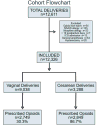Opioid prescribing patterns among postpartum women
- PMID: 29630887
- PMCID: PMC6019620
- DOI: 10.1016/j.ajog.2018.04.003
Opioid prescribing patterns among postpartum women
Abstract
Background: Women commonly receive opioid prescriptions following hospitalization. The rise of the opioid epidemic in the United States underscores the importance of a better understanding of prescribing patterns. Although delivery is the most frequent reason for hospitalization in the United States, there is inadequate knowledge regarding opioid prescribing at postpartum hospital discharge.
Objective: We sought to describe opioid prescribing patterns at the time of discharge following delivery in a large, diverse cohort, and to describe the relationship of these patterns with objective and subjective measures of pain prior to discharge.
Study design: This is a retrospective cohort study of all deliveries at a single, high-volume tertiary care center over a 1-year period. Women were excluded from analysis if they had evidence of recent opioid use, or their labor, delivery, or postpartum course was notable for rare, nonroutine events anticipated to increase pain. Medical records were queried for demographic and clinical data, including whether an opioid prescription was provided at discharge, and if so, details of that prescription. The primary outcome was amount of opioid morphine milligram equivalents prescribed at discharge, described separately for women after vaginal and cesarean deliveries. Among women who received a prescription, we additionally assessed associations between prescription quantity and subjective (patient-reported pain score) and objective (inpatient opioid requirement during the final 24 hours of hospitalization) assessments of pain. Descriptive and bivariable analyses were performed.
Results: Of the total 12,611 women, 12,326 were eligible for inclusion. Of 9038 women postvaginal delivery and 3288 women postcesarean delivery, 30.4% and 86.7% received an opioid prescription at discharge, respectively. Of women receiving discharge opioid prescriptions, median morphine milligram equivalents received was 200 (interquartile range: 120-300) following vaginal and 300 (interquartile range: 200-300) following cesarean delivery. Nearly half (45.7%) of women postvaginal delivery and 18.5% of women postcesarean delivery who received an opioid prescription used 0 morphine milligram equivalent during the final hospital day. Similarly, 26.5% and 18.5% of women after vaginal and cesarean delivery, respectively, reported a pain score of 0 of 10 prior to discharge. Regardless of delivery mode, the amount of opioids prescribed did not differ between those who reported a pain score of 0 of 10 and those who reported a pain score of >0 of 10 immediately prior to discharge. Similarly, for women who underwent cesarean delivery, the morphine milligram equivalents prescribed did not differ between those who used 0 morphine milligram equivalents and those who used >0 in the 24 hours prior to hospital discharge.
Conclusion: Postpartum women are commonly prescribed opioids at the time of postpartum hospital discharge. There is a wide range of morphine milligram equivalents prescribed at hospital discharge following delivery, highlighting a lack of standardization. Furthermore, regardless of objective and subjective measures of pain prior to discharge, women received similar amounts of prescription morphine milligram equivalents following either vaginal or cesarean deliveries.
Keywords: opioid epidemic; opioid prescribing; postpartum pain; prescribing patterns.
Copyright © 2018 Elsevier Inc. All rights reserved.
Conflict of interest statement
DISCLOSURES: The authors report no conflicts of interest.
Figures



Comment in
-
Opioid prescribing patterns among postpartum women.Am J Obstet Gynecol. 2019 Feb;220(2):208. doi: 10.1016/j.ajog.2018.10.011. Epub 2018 Oct 10. Am J Obstet Gynecol. 2019. PMID: 30315785 No abstract available.
-
Reply.Am J Obstet Gynecol. 2019 Feb;220(2):208-209. doi: 10.1016/j.ajog.2018.10.010. Epub 2018 Oct 10. Am J Obstet Gynecol. 2019. PMID: 30315786 No abstract available.
References
-
- Rudd RA, Aleshire N, Zibbell JE, Gladden RM. Increases in Drug and Opioid Overdose Deaths–United States, 2000–2014. MMWR Morb Mortal Wkly Rep. 2016;64(50–51):1378–82. - PubMed
-
- Centers for Disease, C. Prevention, Vital signs: overdoses of prescription opioid pain relievers—United States, 1999–2008. MMWR Morb Mortal Wkly Rep. 2011;60(43):1487–92. - PubMed
-
- Manchikanti L, Helm S, 2nd, Fellows B, Janata JW, Pampati V, Grider JS, Boswell MV. Opioid epidemic in the United States. Pain Physician. 2012;15(3 Suppl):ES9–38. - PubMed
-
- Cicero TJ, Ellis MS, Surratt HL, Kurtz SP. The changing face of heroin use in the United States: a retrospective analysis of the past 50 years. JAMA Psychiatry. 2014;71(7):821–6. - PubMed
Publication types
MeSH terms
Substances
Grants and funding
LinkOut - more resources
Full Text Sources
Other Literature Sources
Medical

